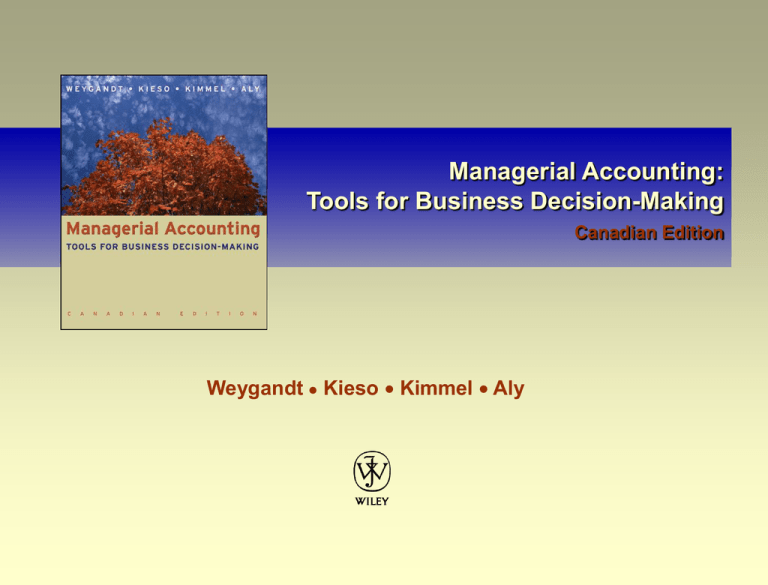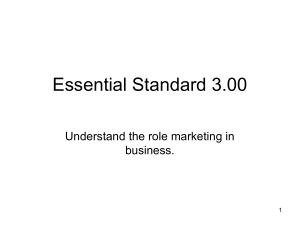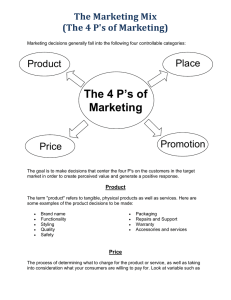
Managerial Accounting:
Tools for Business Decision-Making
Canadian Edition
Weygandt ● Kieso ● Kimmel ● Aly
Chapter 8
Pricing
Chapter 8
Pricing
Study Objectives
Calculate a target cost when a product’s
price is determined by the market.
Calculate target selling price using cost-plus
pricing.
Use time and material pricing to determine
the cost of services provided.
Study Objectives: Continued
Define “transfer price” and its role in an
organization.
Determine a transfer price using the
negotiated, cost-based, and market-based
approaches.
Explain the issues that arise when
transferring goods between divisions
located in countries with different tax rates.
External Sales
Many factors affect price
Product price should cover costs and earn a
reasonable profit
Must have a good understanding of market forces for
appropriate price
Pricing Objectives
•Gain market share
•Achieve a target
rate of return
Demand
•Price sensitivity
•Demographics
What Prices
Should
Be Charged?
Environment
•Political reaction to
prices
•Patent or copyright
protection
Cost Considerations
•Fixed and variable costs
•Short-run or long-run
External Sales
(Continued)
A company can accept the price as set by the
competitive market (supply and demand)
Market sets price when product cannot be easily
differentiated from competing products
Examples: farm products and minerals
A company can set the price when
Product is specially made
One of a kind
No one else produces the product
Company can differentiate its product
from others
Examples: Designer dress and patent or copyright
on a unique process
Target Costing
In a highly competitive market, price is largely
determined by supply and demand
Must control costs to earn a profit
Target cost – cost that provides the desired
profit on a product when the seller does not
have control over the product’s price
Target Costing
Steps
1) Find market niche
Select segment to compete in, For example, luxury
goods or economy goods
2) Determine target price: Price that company believes would
place it in the optimal position for its target audience
Use market research
3) Determine target cost: Difference between target price and
desired profit
Includes all product and period costs necessary to
make and market the product
4) Assemble expert team:
Includes production, operations, marketing, finance
Design and develop a product that meets quality
specifications while not exceeding target cost
Cost-Plus Pricing
May have to set own price where there is little
or no competition
Price typically a function of product cost
Steps:
Establish a cost base
Add a markup (based on desired operating
income or return on investment)
Cost + (Mark-up % x Cost) = Target Selling Price
Cost-Plus Pricing
Example
Cleanmore Products, manufactures of wet/dry shop
vacuums has following Cost data at budgeted sales
volume of 10,000 Units.
Cleanmore has decided to price its new shop vacuum to
earn a 20-percent return on its investment (ROI) of $1
million.
Cost-Plus Pricing
Example (Continued)
Total fixed cost per unit:
(280,000+240,000) ÷ 10,000 = 52
Expected ROI:
20% ROI of $1,000,000 = $200,000
Expected ROI per unit:
$200,000 ÷ 10,000 units = 20
Expected Selling Price:
60+ 52 + 20 = $132 per unit
Cost-Plus Pricing
Limitations
Advantage – Easy to calculate
Disadvantages:
Does not consider demand side
Will the customer pay the price?
Fixed cost per unit changes with change in
volume
At lower sales volume, company must charge
higher price to meet desired ROI
Variable Cost Pricing
Alternative pricing approach:
Simply add a markup to variable costs
Avoids using poor cost information related
to fixed costs per unit
Useful in pricing special orders or when
excess capacity exists
Major disadvantage:
Prices set too low to cover fixed costs
Let’s Review
Cost-plus pricing means that:
a.
Selling price = Variable cost + (Markup
percentage + Variable cost)
b.
Selling price = Cost + (Markup percentage x
Cost)
c.
Selling price = Manufacturing cost + (Markup
percentage + Manufacturing cost)
d.
Selling price = Fixed cost + (Markup
percentage x Fixed cost)
Let’s Review: Solution
Cost-plus pricing means that:
a.
Selling price = Variable cost + (Markup
percentage + Variable cost)
b.
Selling price = Cost + (Markup percentage x
Cost)
c.
Selling price = Manufacturing cost + (Markup
percentage + Manufacturing cost)
d.
Selling price = Fixed cost + (Markup
percentage x Fixed cost)
Time and Material Pricing
An approach to cost-plus pricing in which
the company uses two pricing rates:
One for the labour used on a job
One for the material
Widely used in service industries, especially
professional firms
Public accounting
Law
Engineering
Time and Material Pricing
Example
LAKE HOLIDAY MARINA
Budgeted Costs for the Year 2005
Time Charges
Mechanics’ wages and benefits
Parts manager’s salary and benefits
Office employee’s salary and benefits
Other overhead (supplies, amortization,
property taxes, advertising, utilities)
Total budgeted costs
¹ The invoice cost of the materials is not included in
the material loading charges.
$103,500
0
20,700
Material
Loading
Charges¹
$0
11,500
2,300
26,800
$151,000
14,400
$28,200
Time and Material Pricing
Example (Continued)
Determine a charge for labour time
Express as a rate per hour of labour; Rate includes:
Direct labour cost of employees (includes
fringe benefits)
Selling, administrative, and similar overhead
costs
Allowance for desired profit (ROI) per hour of
employee time
Labour rate for Lake Holiday Marina for 2005 based on:
5,000 hours of repair time
Desired profit margin of $8 per hour
Time and Material Pricing
Example – Lake Holiday Marina (Continued)
Total
Cost
Per Hour
Hourly labour rate for repairs
Mechanics wages/benefits $103,500
Overhead Costs
Office employees
salaries/benefits
20,700
Office overhead
26,800
Total hourly cost
$151,000
Profit Margin
Rate charged per hour of labour
÷
Total
Hours
=
Per Hour
Charge
$20.70
÷
5,000
=
÷
÷
÷
5,000
5,000
15,000
=
=
=
4.14
5.36
$30.20
8.00
$38.20
Time and Material Pricing
Example (Continued)
Calculate the Material Loading Charge
Material loading charge added to invoice price of
materials to determine materials price
Estimated annual costs of purchasing, receiving,
handling, storing + desired profit margin on
materials
Expressed as a percentage of estimated annual
parts and materials cost:
Estimated purchasing, receiving,
handing, storing costs
Estimated costs of parts/materials
+
Desired profit margin
on materials
Time and Material Pricing
Example –Lake Holiday Marina (Continued)
Per Hour
Overhead costs
Parts manager’s salary and
benefits
Office employee’s salary
Other overhead
Profit margin
Material loading percentage
Material
Loading ÷
Charges
Total Invoice
Costs Parts =
and Material
Material
Loading
Percentage
$11,500
2,300
13,800
4,400
$28,200
$120,000
120,000
120,000
11.50%
12.00%
23.50%
20.00%
43.50%
÷
÷
÷
=
=
=
Time and Material Pricing
Example (Continued)
Calculate Charges for
a Particular Job =
Labour charges
+
Material charges
+
Material loading
charge
Time and Material Pricing
Example (Continued)
Determine a price quote to refurbish a pontoon boat:
Estimated 50 hours of labour
Estimated $3,600 parts and materials
Internal Sales
Vertically integrated companies – grow in direction of
customers or supplies
Frequently transfer goods to other divisions as well as
outside customers
How do you price goods when they are “sold” within the company?
Internal Sales
Transfer price – price used to record the transfer
between two divisions of a company
Ways to determine a transfer price:
Negotiated transfer prices
Cost-based transfer prices
Market-based transfer prices
Conceptually - a negotiated transfer price is best
Due to practical considerations, other two methods
are more widely used
Negotiated transfer prices is determined by agreement of
the division managers when no external market price is
available
Negotiated Transfer Price
Example: Alberta Company
Sells hiking boots as well as soles for work & hiking boots
Structured into two divisions: Boot and Sole
Sole Division - sells soles externally
Boot Division - makes leather uppers for hiking boots
which are attached to purchased soles
Each Division Manager compensated on division profitability
Management now wants Sole Division to provide at least
some soles to the Boot Division
Negotiated Transfer Price
Example: Alberta Company (Continued)
Divisional Contribution Margin Per Unit
(Boot Division purchases soles from outsiders)
What would be a fair transfer price if the Sole Division
sold 10,000 soles to the Boot Division?
Negotiated Transfer Price
Example: Alberta Company (Continued)
Sole Division has no excess capacity
If Sole sells to Boot, payment must at least cover
variable cost per unit plus its lost
contribution margin per sole (opportunity cost)
The minimum transfer price acceptable to Sole:
Maximum Boot Division will pay
what the sole would cost from an outside buyer
Negotiated Transfer Price
Example: Alberta Company (Continued)
Sole Division has excess capacity
Can produce 80,000 soles, but can sell only 70,000
Available capacity of 10,000 soles
Contribution margin is not lost
The minimum transfer price acceptable to Sole:
Negotiate a transfer price between $11 (minimum
acceptable to Sole) and $17 (maximum acceptable to Boot)
Negotiated Transfer Price
Variable Costs
In the minimum transfer price formula,
variable cost is the variable cost of units sold
internally
May differ – higher or lower – for units sold
internally versus those sold externally
The minimum transfer pricing formula can
still be used – just use the internal variable
costs
Negotiated Transfer Price
Summary
Transfer prices established:
Minimum by selling division
Maximum by the buying division
Often not used because:
Market price information sometimes not available
Lack of trust between the two divisions
Different pricing strategies between divisions
Therefore, companies often use cost or market based
information to develop transfer prices
Cost-Based Transfer Prices
Uses costs incurred by the division producing
the goods as its foundation
May be based on variable costs or variable
costs plus fixed costs
Markup may also be added
Can result in improper transfer prices causing:
Loss of profitability for company
Unfair evaluation of division performance
Cost-Based Transfer Prices
Example: Alberta Company
Base transfer price on variable cost of sole and no excess
capacity
Bad deal for Sole Division – no profit on transfer of 10,000
soles and loses profit of $70,000 on external sales.
Boot Division increases contribution margin by $6 per sole
Cost-Based Transfer Prices
Example: Alberta Company (Continued)
Sole Division has excess capacity:
Continues to report zero profit but does not
lose the $7 per unit due to excess capacity
Boot Division gains $6
Overall, company is better off by
$60,000 (10,000 X 6)
Does not reflect Sole Division’s true
profitability
Cost-Based Transfer Prices
Summary
Disadvantages
Does not reflect a division’s true profitability
Does not provide an incentive to control
costs which are passed on to the next
division
Advantages
Simple to understand
Easy to use due to availability of information
Market information often not available
Most common method
Market-Based Transfer Prices
Based on existing market prices of competing
products
Often considered best approach because:
Objective
Economic incentives
Indifferent between selling internally and externally
if can charge/pay market price
Can lead to bad decisions if have excess capacity
Why? No opportunity cost.
Where there is not a well-defined market price,
companies use cost-based systems
Effect of Outsourcing on Transfer
Prices
Contracting with an external party to provide a
good or service, rather than doing the work
internally
Virtual Companies outsource all of their
production
As outsourcing increases, fewer components are
transferred internally between divisions
Use incremental analysis to determine if
outsourcing is profitable
Transfers between Divisions in
Different Countries
Going global increases
transfers between divisions
located in different countries
60% of trade between countries
estimated to be transfers
between divisions
Different tax rates make
determining appropriate
transfer price more difficult
Transfers between Divisions in
Different Countries
Example: Alberta Company
Boot Division is in a country with 10% tax rate
Sole Division is located in a country with a 30% rate
The before-tax total contribution margin is $44
regardless of whether the transfer price is $18 or $11
The after-tax total is
$38.20 using the $18 transfer price, and
$39.60 using the $11 transfer price
Why? More of the contribution margin is attributed
to the division in the country with the lower tax rate.
Transfers between Divisions in
Different Countries
Example: Alberta Company (Continued)
Copyright
Copyright © 2006 John Wiley & Sons Canada, Ltd. All
rights reserved. Reproduction or translation of this work
beyond that permitted by Access Copyright (The Canadian
Copyright Licensing Agency) is unlawful. Requests for
further information should be addressed to the Permissions
Department, John Wiley & Sons Canada, Ltd.
The
purchaser may make back-up copies for his or her own use
only and not for distribution or resale. The author and the
publisher assume no responsibility for errors, omissions, or
damages caused by the use of these programs or from the
use of the information contained herein.






